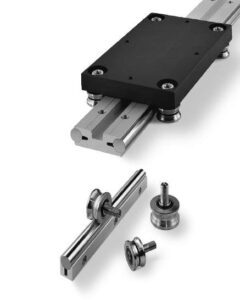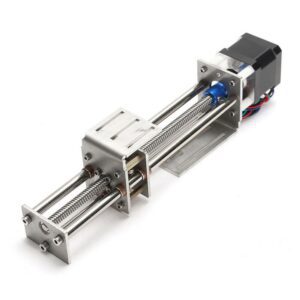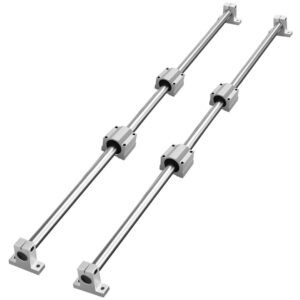Outline for Roller Linear Guide
| Main Heading | Sub-Headings |
|---|---|
| Introduction to Roller Linear Guide | Definition and working principle of roller linear guide |
| Understanding the Role of Roller Linear Guide | Why precision matters in linear motion |
| Types of Roller Linear Guide | Full roller guides, crossed roller guides, needle roller guides |
| Key Components of a Roller Linear Guide | Rails, carriages, rollers, cages |
| How Roller Linear Guide Differs from Ball Linear Guide | Advantages of rollers over balls |
| Material Selection in Roller Linear Guide | Stainless steel, carbon steel, composite materials |
| Load Capacity of Roller Linear Guide | Static load vs dynamic load |
| Accuracy and Precision in Roller Linear Guide | Motion stability and repeatability |
| Applications of Roller Linear Guide in Industrial Automation | Robotics, CNC machines, packaging industry |
| Use of Roller Linear Guide in Medical Equipment | Imaging systems, surgical robotics |
| Benefits of Roller Linear Guide in Heavy-Duty Applications | High rigidity, shock resistance |
| Lubrication Requirements of Roller Linear Guide | Types of lubricants, lubrication intervals |
| Installation Guidelines for Roller Linear Guide | Alignment, mounting, torque requirements |
| Common Challenges with Roller Linear Guide | Misalignment, contamination, wear issues |
| Maintenance Tips for Roller Linear Guide | Cleaning, inspection, replacement schedules |
| Roller Linear Guide in Aerospace and Defense | High-load applications in aircraft systems |
| Comparing Roller Linear Guide with Magnetic Linear Guide | Pros and cons of both systems |
| Environmental Factors Affecting Roller Linear Guide Performance | Temperature, dust, humidity |
| Innovations in Roller Linear Guide Technology | Coatings, smart sensors, lightweight designs |
| Cost Considerations for Roller Linear Guide | Initial cost vs long-term benefits |
| Roller Linear Guide for High-Speed Applications | Vibration control and noise reduction |
| Sustainability in Roller Linear Guide Manufacturing | Eco-friendly materials and recycling |
| Choosing the Right Roller Linear Guide for Your Needs | Selection parameters and expert advice |
| Future of Roller Linear Guide Systems | Trends in automation and AI-driven manufacturing |
| Roller Linear Guide | Summary of its importance and use cases |
| Frequently Asked Questions | Six common queries with answers |
| Conclusion | Final thoughts on roller linear guide |
Introduction to Roller Linear Guide
A roller linear guide is an advanced motion system designed to provide precise, smooth, and efficient movement in machinery. Unlike traditional sliding guides, it uses cylindrical rollers that reduce friction while handling high loads with remarkable accuracy. This makes it a cornerstone technology in robotics, CNC machining, aerospace, and medical equipment.
The concept is simple but revolutionary: rollers replace sliding surfaces, ensuring smoother travel, longer service life, and enhanced rigidity. For industries that rely on accuracy down to the micron, the roller linear guide is not just a component—it’s a game-changer.
Understanding the Role of Roller Linear Guide
Precision is the lifeblood of modern manufacturing. Whether it’s a robotic arm assembling electronics or a CNC machine cutting titanium, even the smallest error can lead to costly mistakes. Roller linear guides play a vital role in minimizing motion deviations, ensuring repeatability, and boosting overall performance.
By providing stability under heavy loads, they improve machine accuracy and speed. Furthermore, their low friction design reduces energy consumption, leading to more sustainable and cost-effective operations.
Types of Roller Linear Guide
The world of roller linear guides is diverse, with each type catering to unique applications:
Full Roller Guides – Built for extreme rigidity and load-bearing, commonly used in heavy machinery.
Crossed Roller Guides – Designed for precision applications where accuracy and smooth motion are crucial, such as in optics and medical devices.
Needle Roller Guides – Compact and efficient, often applied in space-limited environments.
Each type has its advantages, making the selection process critical depending on the application.
Key Components of a Roller Linear Guide
A roller linear guide is more than just a rail and a carriage. It’s a precise engineering system with multiple interdependent components that ensure durability, accuracy, and smooth motion.
Rails: These hardened steel tracks act as the foundation. Their precision-ground surfaces guide the rollers and maintain alignment even under high loads. The quality of the rail surface directly impacts system accuracy.
Carriages (or blocks): The carriage houses the rollers and travels along the rail. It’s designed to absorb loads, resist deflection, and keep motion stable. Some designs allow preloading to eliminate clearance.
Rollers: The heart of the system, these cylindrical elements roll between the rail and carriage. Unlike balls, rollers have a larger contact area, enabling higher load capacities and rigidity.
Cages and retainers: These ensure rollers are evenly spaced, reducing friction and preventing uneven wear. Advanced cage designs minimize noise and vibration while extending lifespan.
Together, these parts form a seamless system. When maintained correctly, they provide decades of reliable service. Neglect one component, however, and the whole system suffers—making maintenance just as important as design.
How Roller Linear Guide Differs from Ball Linear Guide
At first glance, ball and roller linear guides look similar. Both use rolling elements to reduce friction. But the key difference lies in the contact area.
Ball guides rely on point contact, which limits load capacity but offers high speed and smooth travel. They’re great for lightweight, fast-moving applications.
Roller guides, on the other hand, use line contact. This distributes loads more evenly, providing significantly higher rigidity and durability. They resist deflection under pressure and excel in heavy-duty environments.
In short: if speed is the priority, ball guides may win. But if accuracy, stiffness, and load capacity matter more, roller guides dominate.
Material Selection in Roller Linear Guide
The materials used in a roller linear guide determine its performance, durability, and resistance to environmental factors.
Stainless Steel: Known for corrosion resistance, ideal for cleanrooms, food processing, and medical equipment.
Carbon Steel: Offers excellent hardness and wear resistance, making it suitable for heavy machinery.
Composite Materials: Increasingly used for lightweight applications, they balance strength with weight reduction.
Additionally, surface coatings like chrome plating, black oxide, or titanium nitride further improve resistance against wear, rust, and friction. Choosing the right material depends on operating conditions—temperature, humidity, and exposure to chemicals all play a role.
Load Capacity of Roller Linear Guide
Load-bearing ability is one of the biggest advantages of roller guides. Their line-contact design enables them to carry loads up to 3x higher than equivalent ball guides.
Static Load Capacity: Refers to the maximum weight a guide can hold without permanent deformation.
Dynamic Load Capacity: Indicates the load it can handle while moving, over millions of cycles, without failure.
Engineers consider not just vertical loads but also moment loads (twisting forces) acting in multiple directions. That’s why roller guides are used in CNC machining centers and aerospace—where both high accuracy and heavy loads are essential.
Accuracy and Precision in Roller Linear Guide
In industries like semiconductor manufacturing or medical robotics, accuracy is non-negotiable. Roller guides shine here due to:
Minimal deflection under load – thanks to line contact.
High repeatability – ensuring the same motion every time.
Smooth travel – reducing vibration and noise, critical in high-speed precision systems.
Manufacturers often guarantee micrometer-level accuracy over long distances, which ball guides cannot consistently achieve under heavy loads.
Applications of Roller Linear Guide in Industrial Automation
Industrial automation has skyrocketed in recent years, and roller linear guides are its unsung heroes.
Robotics: Arms and gantries rely on guides for smooth, precise movement.
CNC machines: From lathes to milling machines, roller guides provide rigidity needed for accurate cutting.
Packaging industry: Guides handle repetitive high-speed movements, ensuring efficiency and reliability.
By reducing downtime and increasing efficiency, roller guides help factories achieve Industry 4.0 standards—smarter, faster, more sustainable operations.
Use of Roller Linear Guide in Medical Equipment
Modern healthcare demands precision. Roller linear guides play a critical role in:
Imaging equipment (CT, MRI, X-ray scanners) – ensuring precise table movements.
Surgical robotics – guiding robotic arms with flawless accuracy.
Diagnostic devices – providing stability in sample handling systems.
Here, low noise, corrosion resistance, and micro-level accuracy are as important as load-bearing. Stainless steel and coated designs are typically preferred to meet strict hygiene standards.
Benefits of Roller Linear Guide in Heavy-Duty Applications
Where brute force meets fine precision, roller guides excel. Their main benefits in heavy industries include:
High rigidity: Essential in aerospace machining.
Shock resistance: Withstanding sudden impacts without deformation.
Durability: Long lifespan even in demanding environments.
Industries like shipbuilding, steel manufacturing, and mining rely on roller guides to balance heavy loads with precision movement.
Lubrication Requirements of Roller Linear Guide
Lubrication is the lifeblood of any motion system, and roller linear guides are no exception. Proper lubrication ensures reduced friction, smoother operation, and a longer lifespan. Without it, even the strongest steel can wear prematurely.
There are two primary approaches:
Grease lubrication: Ideal for applications with moderate loads and lower speeds. It creates a protective film over rolling surfaces, preventing direct metal-to-metal contact.
Oil lubrication: Preferred for high-speed or high-load systems, as it circulates better and carries away heat.
Manufacturers recommend different lubrication intervals depending on usage, environment, and load. In clean environments, lubrication may last for months, while in dusty or wet conditions, frequent relubrication is necessary.
Some modern roller linear guides integrate self-lubricating units, reducing maintenance needs and ensuring consistent performance over years of operation.
Installation Guidelines for Roller Linear Guide
Installing a roller linear guide requires precision. Even the slightest misalignment can cause uneven roller wear, increased friction, and premature failure.
Key considerations include:
Surface preparation: The mounting base must be flat, rigid, and free from debris.
Alignment: Rails should be parallel, with tolerances in micrometers for high-precision applications.
Preloading: Adjusting the carriage preload ensures zero clearance, which enhances stiffness.
Torque settings: Bolts must be tightened evenly to prevent distortion of the rails.
Many manufacturers provide installation kits, including jigs, measuring tools, and torque wrenches, to simplify the process. Following the guidelines ensures the system operates at maximum performance and avoids costly downtime.
Common Challenges with Roller Linear Guide
Despite their benefits, roller linear guides face challenges in demanding environments. The most common include:
Misalignment: Caused by poor installation or base deformation. Leads to uneven loading and wear.
Contamination: Dust, dirt, or chips entering the guide can cause blockages and damage.
Lubrication failure: Dry running dramatically increases wear and friction.
Corrosion: In humid or chemical-rich environments, unprotected steel can deteriorate quickly.
The good news? With preventive measures—such as protective seals, stainless-steel rails, and routine inspections—most challenges can be mitigated effectively.
Maintenance Tips for Roller Linear Guide
A roller linear guide is a long-term investment, and like any asset, it thrives on proper care.
Here’s a simple but effective maintenance checklist:
Regular cleaning: Remove dust and debris from the rails and carriage.
Lubrication checks: Reapply grease or oil at recommended intervals.
Inspection of rollers: Look for uneven wear, pitting, or scratches.
Carriage tightness: Ensure bolts remain properly torqued.
Replacement schedule: Even the best guides wear over time; schedule replacements before failures occur.
Routine care not only extends the life of the guide but also improves machine uptime, productivity, and accuracy.
Roller Linear Guide in Aerospace and Defense
Few industries demand as much precision and reliability as aerospace and defense. From aircraft manufacturing to missile guidance systems, roller linear guides serve critical roles.
Aircraft assembly lines: Heavy but delicate parts, like wings and fuselage sections, require precise movement.
Weapon systems: Guidance and targeting platforms depend on smooth, accurate travel.
Satellites: Roller guides help in positioning solar panels and antennas in orbit.
The ability to withstand extreme loads, vibration, and temperature fluctuations makes roller linear guides indispensable in these fields.
Comparing Roller Linear Guide with Magnetic Linear Guide
While roller guides rely on mechanical contact, magnetic linear guides use magnetic levitation for near-frictionless motion. Each has unique strengths.
Roller Linear Guide: High load capacity, excellent rigidity, well-suited for heavy-duty and high-precision applications.
Magnetic Linear Guide: Virtually no friction, enabling ultra-smooth motion at high speeds, but limited in load capacity and more expensive.
For applications like semiconductor manufacturing, magnetic guides may be preferred. For industries requiring both heavy loads and cost-effectiveness, roller guides remain the top choice.
Environmental Factors Affecting Roller Linear Guide Performance
Operating conditions directly influence the performance and lifespan of roller linear guides.
Temperature: Excessive heat can degrade lubrication, while freezing conditions can cause brittleness.
Humidity: Moist environments increase the risk of rust, especially in carbon steel.
Dust and debris: Common in woodworking or metal-cutting industries, contamination can clog rollers.
Chemical exposure: Certain solvents or acids corrode unprotected surfaces.
Protective covers, seals, and corrosion-resistant materials are essential in harsh environments. Choosing the right guide depends on balancing application demands with environmental realities.
Innovations in Roller Linear Guide Technology
The world of roller linear guides continues to evolve, driven by demands for higher precision and efficiency.
Recent innovations include:
Advanced coatings: Diamond-like carbon (DLC) coatings reduce wear and improve corrosion resistance.
Smart sensors: Built-in monitoring systems track load, temperature, and lubrication status in real time.
Lightweight designs: Composite materials reduce weight without compromising strength.
Noise reduction systems: Specialized cage designs minimize vibrations and acoustic emissions.
These advancements not only extend guide lifespan but also enable smarter, more connected manufacturing systems.
Cost Considerations for Roller Linear Guide
When evaluating roller linear guides, cost isn’t just about the purchase price. The true value lies in lifecycle costs.
Initial cost: Roller guides tend to be more expensive than ball guides.
Maintenance savings: Longer lifespan and durability reduce downtime costs.
Energy efficiency: Low friction means less energy consumption in automated systems.
Productivity gains: Higher accuracy translates into fewer errors and higher yields.
For industries where precision is vital, the higher upfront investment often pays off in long-term savings.
Roller Linear Guide for High-Speed Applications
High-speed automation requires more than just speed—it requires stability. Roller linear guides provide both.
Vibration control: Their rigidity reduces chatter at high speeds.
Noise reduction: Roller cages and dampening designs minimize operational noise.
Heat management: With proper lubrication, frictional heat remains low.
This makes them suitable for electronics manufacturing, high-speed packaging, and automated inspection systems.
Sustainability in Roller Linear Guide Manufacturing
Sustainability has become a major focus in modern engineering, and roller linear guides are no exception.
Eco-friendly materials: Recyclable steels and composites reduce environmental impact.
Energy-efficient designs: Lower friction equals reduced energy use.
Extended lifespan: Durable guides mean fewer replacements and less waste.
Green coatings: Advanced coatings avoid harmful chemicals while improving performance.
Sustainability not only benefits the planet but also strengthens a manufacturer’s reputation in global markets.
Choosing the Right Roller Linear Guide for Your Needs
Selecting the right roller guide is a balancing act. Factors to consider include:
Load capacity – Will it carry heavy or light loads?
Precision requirements – Is micrometer-level accuracy needed?
Operating environment – Will it face dust, heat, or chemicals?
Speed – Is the application high-speed or low-speed?
Cost – Does the budget allow for higher upfront investment?
Consulting with experts and suppliers ensures the system meets both present and future needs.
Future of Roller Linear Guide Systems
As automation, robotics, and artificial intelligence advance, roller linear guides will continue to evolve. The future points toward:
Self-monitoring systems that predict wear before failures occur.
Hybrid systems combining rollers with magnetic guidance.
Ultra-light materials that maintain strength but reduce inertia.
Integration with AI-driven manufacturing, where guides adjust themselves for optimal performance.
The roller linear guide will remain central to industries seeking speed, accuracy, and sustainability.
Roller Linear Guide
In summary, the roller linear guide is far more than a mechanical component—it’s the backbone of precision engineering. With its high load capacity, rigidity, and adaptability, it supports industries from aerospace to medical robotics. When properly installed, maintained, and selected, it provides unmatched performance for decades.




